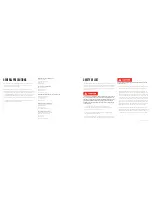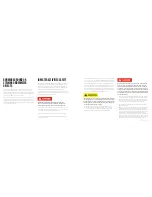
2017 OWNERS MANUAL /
16
Fire extinguishers require periodic maintenance. Monthly, each fire
extinguisher on your boat should be examined to be sure that the
seals and tamper indicators are not broken or missing. The pres-
sure gauges or indicators, if applicable, should read in the operable
range. There should be no obvious physical damage, rust, corrosion,
leakage or clogged nozzles. Additionally, if the extinguisher has
not been used, it should be weighed annually to assure that the
minimum weight as stated on the label still exists. Any fire extin-
guisher that has been partially emptied must be replaced as soon
as possible.
In an automatic/manual system, ensure the pin inserted to protect
the system at the helm during transit from the factory (pictured
above) has been pulled to activate the system. This is part of dealer
preparation, but it is the responsibility of the boat owner to ensure
that the system is functional.
CAPSIZING
In addition to fire, a boater’s greatest concern may be with the
possibility of capsizing or overturning the boat. A number of
factors can occur that will result in a boat overturning (high waves,
excessive wakes, bad weather) or sinking as a result of damage
such as striking an underwater object or another boat.
In the event of such an occurrence, try to turn the engine OFF.
Attempt to locate any other people who were on-board and
determine whether they are injured. Unless there is fire or release of
gasoline, in most instances it is wise to remain with the boat. Except
the cases of sinkable damage, it will float. Climbing on the hull will
make it easier for rescuers to locate you and others.
should be used in situations other than engine compartment fires.
Hand-held units should be replaced or recharged as soon as
possible after use. Chemical discharge should be cleaned from all
surfaces as soon as possible and prior to running the boat again,
unless operation is necessary to return to shore.
The boat should never be operated following a fire until after a
determination has been made whether operation may result in an-
other fire. If any danger of an additional fire exists, the boat should
be towed to shore or dock rather than running the engine(s).
Consumers who choose to purchase fire control equipment from
resources other than MasterCraft must follow the instructions and
requirements as listed within the engine compartment regarding
suitability for the compartment volume. These standards are estab-
lished by the Coast Guard Code of Federal Regulations (CFR) and
the American Boat and Yacht Council (ABYC).
Following the activation of the automatic fire suppression system
or a hand-held fire extinguisher, a careful determination should be
made as to whether the boat can safely be operated. If there is any
doubt or concern whatsoever, the boat should be towed to shore
and/or dock for service by an authorized MasterCraft dealer prior
to operating again. Failure to follow these instructions could result
in death or serious injury/illness.
FIRE SUPPRESSION
AND EXTINGUISHING
All MasterCraft boats are equipped with an automatic fire suppres-
sion system. The automatic system operates from sensors in the
engine room and will automatically release a clean-agent, gaseous
chemical that does not leave residue behind.
It is also possible to activate the system manually on the domestic
boats only. Pull the pin with the red tag (pictured to left), and then
pull the red fire handle to set the system in operation. (International
boats are automatic only.)
In case of an engine compartment fire, shut down the engine and
blowers before manual discharge, or immediately following the
automatic discharge. Boats are equipped with a discharge indica-
tion light at the instrument panel or on the video display gauge at
the helm.
After the suppression system has been used, the fire extinguisher
canister will be empty. The boat owner/operator should have the
canister replaced as soon as possible.
MasterCraft boats have also been specified to carry a hand-held 2.5
lb. monoammonium phosphate expellant (dry chemical) unit, which
is rated Class A (trash, wood and paper), Class B (flammable liquids,
fuel, gas) and Class C (energized electrical equipment). These units
Содержание NXT20 2017
Страница 3: ...2017 OWNERS MANUAL SAFETY KNOWLEDGE ...
Страница 27: ...2017 OWNERS MANUAL 48 2017MODEL FEATURESANDSPECS ...
Страница 40: ...2017 OWNERS MANUAL 74 DASHESAND VIDEOSCREENS ...
Страница 42: ...2017 OWNERS MANUAL 78 XANDXTSERIESINSTRUMENTPANEL 4 3 VIDEOSCREEN XSTARINSTRUMENTPANEL ...
Страница 43: ...2017 OWNERS MANUAL 80 PROSTARINSTRUMENTPANEL NXTSERIESINSTRUMENTPANEL ...
Страница 58: ...2017 OWNERS MANUAL 110 XANDXTSERIES VIDEOSCREEN OPERATIONSHV450 ...
Страница 67: ...2017 OWNERS MANUAL 128 XSTAR VIDEOSCREEN OPERATIONS XSTARINSTRUMENTPANEL ...
Страница 80: ...2017 OWNERS MANUAL 154 PROSTAR VIDEOSCREEN OPERATIONS ...
Страница 97: ...2017 OWNERS MANUAL 188 NXT OPERATIONS ...
Страница 101: ...2017 OWNERS MANUAL 196 NXT20 22 VIDEOSCREEN OPERATIONS ...
Страница 107: ...2017 OWNERS MANUAL 208 BOAT OPERATIONS ...
Страница 158: ...2017 OWNERS MANUAL 310 PREPARATION ...
Страница 172: ...2017 OWNERS MANUAL 338 CAREAND MAINTENANCE ...
Страница 204: ...2017 OWNERS MANUAL 402 TRAILERS ...












































